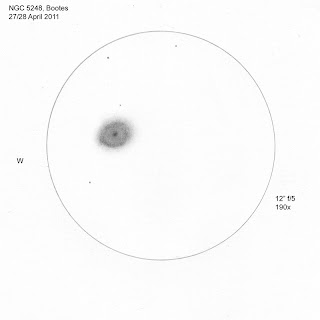Yesterday, 19th August, was one of the every-other-day warm and sunny ones in this strange mixed bag of a summer. The evening was cloudless and, although the Moon was going to rise before it got astronomically dark and it was forecast to cloud over later, I decided to set up the 8″ Newtonian and catch some low southern globulars. The 8″ is a good scope to get low objects because its tripod is higher than my 12″ scope’s Dobsonian mount and, as such, I can get at the hedgehopper objects, objects that are inaccessible with the bigger scope.
Date: 19th August 2011
Conditions: Clear at first, rising 75% illuminated gibbous Moon, dew.
Transparency: I, deteriorating later on as clouds appeared
Seeing: III
NELM: 5.9 under the gibbous Moon
Equipment: 8″ f/4 equatorial Newtonian. Televue 22mm Panoptic (36x), Televue 15mm Plossl (53x), Televue 8mm Radian (100x), Televue 5mm Radian (166x) and Televue 3mm Radian (267x).
NGC 6642, globular cluster in Sagittarius – Found easily at 36x, it is small, bright and round. Unresolved at 53x and remains unresolved at 100x although it does look slightly granular. Condenses to a bright core. Outlying halo looks granular but not resolved. 36x, 53x, 100x
Palomar 9 (NGC 6717), globular cluster in Sagittarius – You see the word ‘Palomar’ and you think ‘not easy’ but this one is not that hard, even in an 8″. However, it would be easily overlooked if you weren’t actually looking for it. Palomar 9 is right next to Nu 2 Sgr, a 5th magnitude star, and is slightly overwhelmed by it.
Pal 9 is very small round patch with a brighter, tiny, core. Totally unresolved. 100x, 160x, 267x.
I packed up at 2330 because clouds were forming, as forecast, and the Moon was getting higher. I only observed two objects in 50 minutes, as most of my targets were getting too low and had vanished behind the garden hedge.








